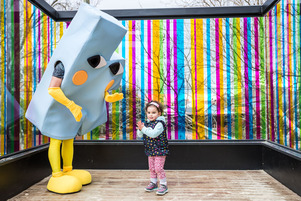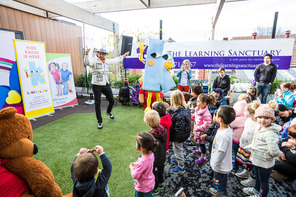Australia - Services on Air - History
16.04.2020
A full listing of the services on air in Australia is available at http://www.digitalradioplus.com.au/.
CRA reports 139 stations are broadcasting on DAB+ in Australia, with up to 30 DAB+ only stations in each mainland state capital city. There are currently 13 regular regional multiplexes and 2 trial regional multiplexes on air broadcasting nearly 210 DAB+ services between them, with most multiplex delivering 18 or more services. There are 74 radio stations on AM/FM in the five capital cities, counting commercial, ABC and SBS but not community stations.
Almost all stations in Australia are using slideshow and all are delivering dynamic scrolling text.
There is no format restriction for Australian DAB+ services, so stations can develop new formats and test the audience’s interest in these digital only services. Stations include dance, children’s programming, chill, 80s, 90s, classic, jazz, indie and world music as well as sport and talk. Pop up stations have been used for cultural celebrations, anniversaries of major events, floods and emergencies. Revenue is being made on branded radio stations for retail clients and advertisers and state capital city. All services have DAB+ broadcast text and slideshow data included, with many stations having track now playing, news and weather information, as well as advertisements in their slideshow broadcasts. At least one ensemble in each city is broadcasting an Electronic Programme Guide (EPG).
Coutts Report
A report by Commercial Radio Australia (CRA) and written by Professor Reg Coutts, found that mobile broadband communications networks, particularly in regional areas, are not a replacement for broadcast free to air radio.
The Coutts Report highlights that mobile networks in regional Australia are less cost effective compared to a potential DAB+ digital radio rollout in regional areas. Even with upgraded 4G networks using the most advanced LTE broadcast mode, there are technical and economic reasons for radio to be delivered using free to air broadcast technology in both regional and metropolitan areas.
The Coutts report cleared up a lot of misperceptions around the future of broadcast radio, mobile networks and the delivery of radio online showing it may not yet, or even in the longer term, be technically or financially viable.
Key findings are listed below and the full Coutts Report is available at www.digitalradioplus.com.au
Digital radio station Innovation
Australian broadcasters have innovated with the use of event or pop up stations which are digital stations that exist for a short period of time to allow for flexible niche programming that can highlight an event, a festival or artist. They can be used for generating additional revenue, broadcasting emergency service warnings during fire or the recent Queensland floods and also for broadcasting sports or music events. For example Elf Radio plays Christmas songs throughout the festive season and the Chemist Warehouse station was established specifically for an advertising client and that station has been so successful for the broadcaster and client that it will continue on air.
Coles supermarkets and Nova Entertainment have signed a major partnership to digitally stream Coles Radio to over 750 stores - reaching over 14 million customers nationally, every week. Using the Coles digital network, Coles Radio is set up to enhance the customer in-store experience with a rich music format offering an extensive playlist that is tailored to the time of day. Read the press release here.
21.06.2018
A full listing of the services on air in Australia is available at http://www.digitalradioplus.com.au/.
CRA reports 139 stations are broadcasting on DAB+ in Australia, with up to 30 DAB+ only stations in each mainland state capital city. There are currently 13 regular regional multiplexes and 2 trial regional multiplexes on air broadcasting nearly 210 DAB+ services between them, with most multiplex delivering 18 or more services. There are 74 radio stations on AM/FM in the five capital cities, counting commercial, ABC and SBS but not community stations.
Almost all stations in Australia are using slideshow and all are delivering dynamic scrolling text.
There is no format restriction for Australian DAB+ services, so stations can develop new formats and test the audience’s interest in these digital only services. Stations include dance, children’s programming, chill, 80s, 90s, classic, jazz, indie and world music as well as sport and talk. Pop up stations have been used for cultural celebrations, anniversaries of major events, floods and emergencies. Revenue is being made on branded radio stations for retail clients and advertisers and state capital city. All services have DAB+ broadcast text and slideshow data included, with many stations having track now playing, news and weather information, as well as advertisements in their slideshow broadcasts. At least one ensemble in each city is broadcasting an Electronic Programme Guide (EPG).
Coutts Report
A report by Commercial Radio Australia (CRA) and written by Professor Reg Coutts, found that mobile broadband communications networks, particularly in regional areas, are not a replacement for broadcast free to air radio.
The Coutts Report highlights that mobile networks in regional Australia are less cost effective compared to a potential DAB+ digital radio rollout in regional areas. Even with upgraded 4G networks using the most advanced LTE broadcast mode, there are technical and economic reasons for radio to be delivered using free to air broadcast technology in both regional and metropolitan areas.
The Coutts report cleared up a lot of misperceptions around the future of broadcast radio, mobile networks and the delivery of radio online showing it may not yet, or even in the longer term, be technically or financially viable.
Key findings are listed below and the full Coutts Report is available at www.digitalradioplus.com.au
Digital radio station Innovation
Australian broadcasters have innovated with the use of event or pop up stations which are digital stations that exist for a short period of time to allow for flexible niche programming that can highlight an event, a festival or artist. They can be used for generating additional revenue, broadcasting emergency service warnings during fire or the recent Queensland floods and also for broadcasting sports or music events. For example Elf Radio plays Christmas songs throughout the festive season and the Chemist Warehouse station was established specifically for an advertising client and that station has been so successful for the broadcaster and client that it will continue on air.
Coles supermarkets and Nova Entertainment have signed a major partnership to digitally stream Coles Radio to over 750 stores - reaching over 14 million customers nationally, every week. Using the Coles digital network, Coles Radio is set up to enhance the customer in-store experience with a rich music format offering an extensive playlist that is tailored to the time of day. Read the press release here.
27.07.2017
A full listing of the services on air in Australia is available at http://www.digitalradioplus.com.au/. CRA reports 139 stations are broadcasting on DAB+ in Australia, with up to 30 DAB+ only stations in each mainland state capital city. There are currently 13 regular regional multiplexes and 2 trial regional multiplexes on air broadcasting nearly 210 DAB+ services between them, with most multiplex delivering 18 or more services. There are 74 radio stations on AM/FM in the five capital cities, counting commercial, ABC and SBS but not community stations.
1.54 million listeners are tuning in to DAB+ only stations*
*GfK Digital Radio Report - 3, 2016 SMBAP, Cumulative Audience, Mon-Sun, 12mn-12mn, All People 10+ listening to DAB+ stations via DAB+ or internet and listening to AM/FM stations simulcast via DAB+
Almost all stations in Australia are using slideshow and all are delivering dynamic scrolling text.
There is no format restriction for Australian DAB+ services, so stations can develop new formats and test the audience’s interest in these digital only services. Stations include dance, children’s programming, chill, 80s, 90s, classic, jazz, indie and world music as well as sport and talk. Pop up stations have been used for cultural celebrations, anniversaries of major events, floods and emergencies. Revenue is being made on branded radio stations for retail clients and advertisers and state capital city. All services have DAB+ broadcast text and slideshow data included, with many stations having track now playing, news and weather information, as well as advertisements in their slideshow broadcasts. At least one ensemble in each city is broadcasting an Electronic Programme Guide (EPG).
Australian broadcasters are urgently calling on infrastructure providers, PAD server suppliers, chipmakers and receiver manufacturers to urgently provide support for Categorised Slideshow and click through URLs to allow the new hybrid features of DAB+ to be implemented.
Coutts Report
A report released in 2014 by Commercial Radio Australia (CRA) and written by Professor Reg Coutts, finds that mobile broadband communications networks, particularly in regional areas, are not a replacement for broadcast free to air radio.
The report considers the potential for mobile networks to be expanded to a point where they are viable to accommodate all live free to air radio broadcasting at the same high quality to hundreds of thousands of listeners at the same time as a replacement for broadcast radio, and/or instead of rolling out DAB+ digital radio, which is currently available in the five major metropolitan cities.
The Coutts Report highlights that mobile networks in regional Australia are less cost effective compared to a potential DAB+ digital radio rollout in regional areas. Even with upgraded 4G networks using the most advanced LTE broadcast mode, there are technical and economic reasons for radio to be delivered using free to air broadcast technology in both regional and metropolitan areas.
Following the submission to the Federal Government’s Digital Radio Discussion Paper earlier in the year, to assist with future planning, and to introduce into the general discourse the reality of technical capability of both broadcast radio and mobile networks for mass live and local free to air radio delivery, the commercial radio industry commissioned highly respected telecommunications expert, Professor Reg Coutts of Coutts Communications, to analyse the use of mobile telecommunications to deliver free to air broadcast radio in Australia.
The Coutts report cleared up a lot of misperceptions around the future of broadcast radio, mobile networks and the delivery of radio online showing it may not yet, or even in the longer term, be technically or financially viable.
Commercial Radio Australia’s position is that listening to radio online is complementary and not a replacement of broadcast radio, whether it’s analogue or digital. Listeners use streaming as a convenient alternative. The commercial radio industry is continually assessing technological innovation and economic viability. Listeners want to listen to radio wherever they are – in the car, at home, on their phone while in transit and as an industry CRA is constantly exploring the best way to achieve this.
Professor Coutts explains that internet radio on smart phones by itself cannot substitute for broadcast radio. Broadcast digital radio is globally where innovation is happening. Innovative local radio broadcasters need broadcast digital radio which so necessary for regional communities to thrive in the future.
There are 220 commercial regional radio stations throughout Australia and, aside from questions over urban delivery, the report also suggests there is considerable uncertainty as to a plausible business model to support the upgrade of regional mobile networks from 3G to the most advanced form of 4G LTE Broadcast and it would also mean listeners would have to pay via their data plan for what they now can receive at no cost.
Importantly there would be significant impact on mobile cell capacity for other user’s applications (ie social media, internet browsing, video on demand etc) even if LTE Broadcast is able to be used to replicate broadcast radio’s live reach, robustness and quality.
The radio industry has rolled out digital radio in the five state metropolitan capitals and like the television industry, who have completely switched to digital, is looking to secure its digital broadcast future by continuing a phased rollout of broadcast digital radio to regional Australia.
The findings of this Australian study are consistent with recent European reports which show mobile networks complement broadcast radio, but are unlikely to replace it in the foreseeable future.
Key findings are listed below and the full Coutts Report is available at www.digitalradioplus.com.au
Digital radio station Innovation
Australian broadcasters have innovated with the use of event or pop up stations which are digital stations that exist for a short period of time to allow for flexible niche programming that can highlight an event, a festival or artist. They can be used for generating additional revenue, broadcasting emergency service warnings during fire or the recent Queensland floods and also for broadcasting sports or music events. For example Elf Radio plays Christmas songs throughout the festive season and the Chemist Warehouse station was established specifically for an advertising client and that station has been so successful for the broadcaster and client that it will continue on air.
Coles supermarkets and Nova Entertainment have signed a major partnership to digitally stream Coles Radio to over 750 stores - reaching over 14 million customers nationally, every week. Using the Coles digital network, Coles Radio is set up to enhance the customer in-store experience with a rich music format offering an extensive playlist that is tailored to the time of day. Read the press release here.
Featured DAB+ stations
In July 2016 EONSportsRadio launched Australia's very first 24/7 sports radio station on DAB+ providing listeners with even more great content.
Kinderling Kids Radio has partnered with ASX-listed G8 Education to roll out its newest program, Play & Learn, to early education centres across Australia, in a move that could see the broadcaster double its market share.
A first within Australia’s DAB radio space, the initiative will see the SCA-backed, station run a program specifically dedicated to auditory learning activities for a 10-week trial period in 24 centres across Victoria, South Australia and New South Wales.
With the Play & Learn program designed to enhance children’s cognitive and emotional development through a mix of guided auditory exercises, results of the pilot could see the program introduced into all 450 G8 early education centres operating nationally.
Having won Best Digital Radio Format at the 2016 ACRAs and averaging a weekly listenership of 200,000, the uptake would see Kinderling’s average weekly audience double.


